

|
| DEUTSCHLAND | GERMANY |
| Bundesland: Freistaat Bayern | Bavaria |
| Regierungsbezirk: Oberbayern | |
| Stadt: München |
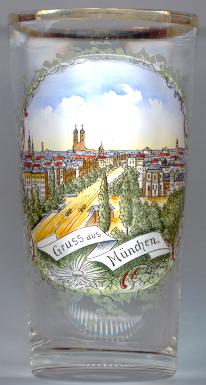 Munich is situated at an elevation of 519 m on the river Isar. The capital of Germany's state of Bavaria
has a population of about 1.3 million and is Germany's third-largest city.
Munich is situated at an elevation of 519 m on the river Isar. The capital of Germany's state of Bavaria
has a population of about 1.3 million and is Germany's third-largest city.
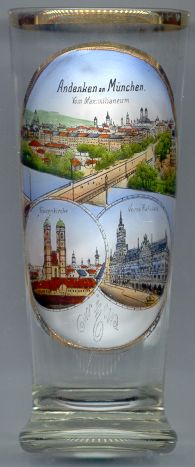 Munichen (Latin Monacum, Monachium) was founded next to an already existing settlement of monks by the
Welf Heinrich the Lion, Duke of Saxony and Bavaria. The village grew next to a bridge. In 1175 Munich was granted
the status of a city and was fortified. In 1180, with the trial of Henry the Lion, Otto I of the Wittelsbach dynasty
became Duke of Bavaria, and Munich was handed over to the bishop of Freising. In 1240 Munich itself was transferred to
Otto II of Wittelsbach and in 1255, when the dukedom of Bavaria was split in two, Munich became the ducal residence
of Upper Bavaria. When Bavaria was reunited in 1506 Munich became capital of the whole of Bavaria. In 1623 during the
Thirty Years' War (1618–1648) Munich became electoral residence when Maximilian I, Duke of Bavaria was invested
with the electoral dignity. In 1705 during the War of the Spanish Succession it was under the control of Austria for some
years since Elector Maximilian II Emanuel made a pact with France. The coronation of his son Elector Karl Albert as
Emperor Karl VII in 1742 led to another Habsburg occupation. From 1789 onwards the old medieval fortifications were
demolished. In 1806, Munich became the capital of the new Kingdom of Bavaria.
Munichen (Latin Monacum, Monachium) was founded next to an already existing settlement of monks by the
Welf Heinrich the Lion, Duke of Saxony and Bavaria. The village grew next to a bridge. In 1175 Munich was granted
the status of a city and was fortified. In 1180, with the trial of Henry the Lion, Otto I of the Wittelsbach dynasty
became Duke of Bavaria, and Munich was handed over to the bishop of Freising. In 1240 Munich itself was transferred to
Otto II of Wittelsbach and in 1255, when the dukedom of Bavaria was split in two, Munich became the ducal residence
of Upper Bavaria. When Bavaria was reunited in 1506 Munich became capital of the whole of Bavaria. In 1623 during the
Thirty Years' War (1618–1648) Munich became electoral residence when Maximilian I, Duke of Bavaria was invested
with the electoral dignity. In 1705 during the War of the Spanish Succession it was under the control of Austria for some
years since Elector Maximilian II Emanuel made a pact with France. The coronation of his son Elector Karl Albert as
Emperor Karl VII in 1742 led to another Habsburg occupation. From 1789 onwards the old medieval fortifications were
demolished. In 1806, Munich became the capital of the new Kingdom of Bavaria.
After World War I, the city was at the center of much unrest. In November 1918 on the eve of revolution, Ludwig III and his family fled Munich. After the murder of the first republican premier of Bavaria, Kurt Eisner, in February 1919 Communists took power establishing the Bavarian Soviet Republic (Münchner Räterepublik) which was put down already on May 3, 1919. In 1923 Hitler and his supporters, who then were concentrated in Munich, staged the Beer Hall Putsch, a failed attempt to overthrow the Weimar Republic and seize power. However, the city would once again become a Nazi stronghold when they took power in Germany in 1933. In 1938, the Munich Agreement was signed in the city, ceding the mostly German speaking Sudetenland, previously a part of Czechoslovakia since the end of World War I, to Germany. It was signed by representatives of Germany, Italy, France and Britain. One year later, in 1939, Georg Elser failed with his attempt to assassinate Hitler while the latter was giving his annual speech to commemorate the Beer Hall Putsch. Munich was the city where the White Rose (Die Weiße Rose), a group of students that formed a resistance movement from June 1942 to February 1943, was based. The core members were arrested following a distribution of leaflets in Munich University by Hans and Sophie Scholl. The city was heavily damaged by allied bombing during World War II. After the war Munich was completely rebuilt following a meticulous and rather conservative plan which preserved its pre-war street grid.
Munich was the site of the 1972 Summer Olympics, during which Israeli athletes were assassinated by Palestinian terrorists. Several games of the 1974 World Cup were also held in the city. In 2006 it will again be host to several games, including the opening match of the FIFA 2006 World Cup.
The current Roman Catholic Pope Benedict XVI (Joseph Ratzinger) was ordained a priest in the Archdiocese of Munich and Freising
on June 29, 1951. Ratzinger served as Archbishop of Munich from 1977 to 1982.
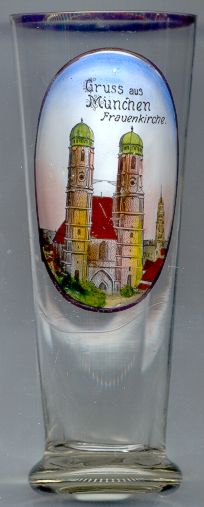
The  Frauenkirche (Dom zu Unserer Lieben Frau) (Cathedral of Our Blessed Lady) [left, no. 1705]
is the largest church in Munich. The cathedral, which replaced an older church built in the 12th century,
was commissioned by Duke Siegmund of Bavaria (from 1467 Bavaria-Dachau). Construction began in 1468 and the two towers were completed in 1488.
The church was consecrated in 1494.
In 1492/1495 the collegiate monastery (Zu Unser ieben Frau) was founded by the unification of the collegiate monasteries of Ilmmünster and Schliersee.
The famous domes atop each tower were added in 1525. In 1803 the colegiate monastery was dissolved. The cathedral suffered severe damage
during World War II; the roof collapsed and one of the towers suffered severe damage. A major restoration was started
after the war and was completed in several stages, the last in 1994. The Frauenkirche was constructed from red brick in the
late Gothic style. The structure is 109 m tall and 40 m wide, the two towers are 99 m high.
Frauenkirche (Dom zu Unserer Lieben Frau) (Cathedral of Our Blessed Lady) [left, no. 1705]
is the largest church in Munich. The cathedral, which replaced an older church built in the 12th century,
was commissioned by Duke Siegmund of Bavaria (from 1467 Bavaria-Dachau). Construction began in 1468 and the two towers were completed in 1488.
The church was consecrated in 1494.
In 1492/1495 the collegiate monastery (Zu Unser ieben Frau) was founded by the unification of the collegiate monasteries of Ilmmünster and Schliersee.
The famous domes atop each tower were added in 1525. In 1803 the colegiate monastery was dissolved. The cathedral suffered severe damage
during World War II; the roof collapsed and one of the towers suffered severe damage. A major restoration was started
after the war and was completed in several stages, the last in 1994. The Frauenkirche was constructed from red brick in the
late Gothic style. The structure is 109 m tall and 40 m wide, the two towers are 99 m high.
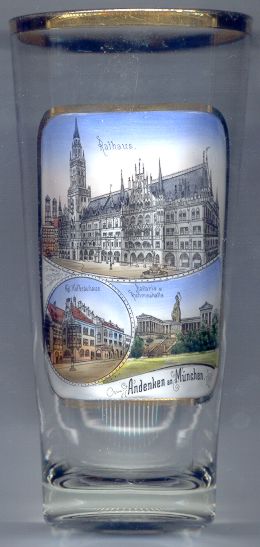
The  New Town Hall [right, no. 1954: top picture]
is the main seat of Munich's city administration. It was built in Gothic revival style between 1867 and 1909 by the architect
Georg von Hauberrisser, who was born in Graz and since 1866 worked in Munich. The design was inspired
by the historic town hall of Brussels and the new town hall of Vienna. During World War II the building
suffered some damaged and was restored and enlarged after the war.
New Town Hall [right, no. 1954: top picture]
is the main seat of Munich's city administration. It was built in Gothic revival style between 1867 and 1909 by the architect
Georg von Hauberrisser, who was born in Graz and since 1866 worked in Munich. The design was inspired
by the historic town hall of Brussels and the new town hall of Vienna. During World War II the building
suffered some damaged and was restored and enlarged after the war.
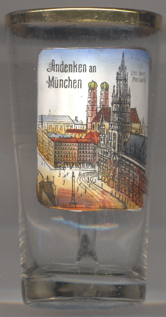
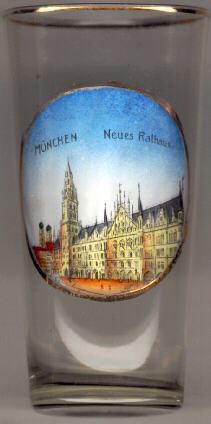
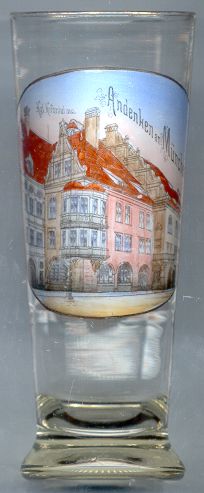
The  Hofbräuhaus [left, no. 1698, and above right, no. 1954: bottom left picture]
is the most famous old beer hall in the city center of Munich.
The inn was originally built in 1589 by the Duke Wilhem V of Bavaria to avoid buying beer for his troops from
Lower Saxony. The general public was admitted only in 1828 by King Ludwig I.
When the brewery moved to the suburbs the building was completely remodeled in 1896/1897 by the architect Max Littmann.
In World War II, everything but
the main inn ("Schwemme") was destroyed; it took until 1958 to be rebuilt.
Hofbräuhaus [left, no. 1698, and above right, no. 1954: bottom left picture]
is the most famous old beer hall in the city center of Munich.
The inn was originally built in 1589 by the Duke Wilhem V of Bavaria to avoid buying beer for his troops from
Lower Saxony. The general public was admitted only in 1828 by King Ludwig I.
When the brewery moved to the suburbs the building was completely remodeled in 1896/1897 by the architect Max Littmann.
In World War II, everything but
the main inn ("Schwemme") was destroyed; it took until 1958 to be rebuilt.
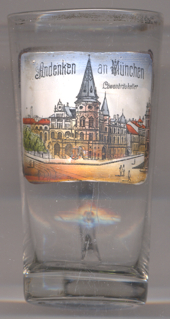
The  Löwenbräukeller [right, no. 3164]
is located in Stiglmaierplatz in Munich's Maxvorstadt. The building was erected in 1882–1883.
The building was severely damaged in 1944, but rebuilt and renovated in 1950–1958.
The brewery is alleged to have been founded around 1383. In 1524, Jörg Schnaitter, a pierprew (beer brewer),
is mentioned in connection with the property at the address 17 Löwengrube.
The brewery was first mentioned in 1746 in the Munich tax records. The lion emblem originates from a 17th-century
fresco in the brewing house, depicting Daniel in the lions' den.
In 1826, brewing operations began moving to a new location on Nymphenburger Strasse; the move was completed in 1851.
By 1863, Löwenbräu had become the largest brewery in Munich, producing a quarter of the city's beer output.
Löwenbräukeller [right, no. 3164]
is located in Stiglmaierplatz in Munich's Maxvorstadt. The building was erected in 1882–1883.
The building was severely damaged in 1944, but rebuilt and renovated in 1950–1958.
The brewery is alleged to have been founded around 1383. In 1524, Jörg Schnaitter, a pierprew (beer brewer),
is mentioned in connection with the property at the address 17 Löwengrube.
The brewery was first mentioned in 1746 in the Munich tax records. The lion emblem originates from a 17th-century
fresco in the brewing house, depicting Daniel in the lions' den.
In 1826, brewing operations began moving to a new location on Nymphenburger Strasse; the move was completed in 1851.
By 1863, Löwenbräu had become the largest brewery in Munich, producing a quarter of the city's beer output.
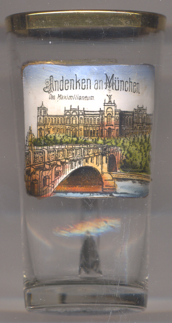
The  Maximilianeum [left]
was built as the home of a gifted students' foundation by an initiative of King Maximilian II of Bavaria
who started the project in 1857. The leading architect was Friedrich Bürklein. The building is situated on the bank of
the river Isar before the Maximilian Bridge and marks the eastern end of the Maximilianstrasse, one of Munich's royal
avenues which is framed by neo-Gothic palaces influenced by the English Perpendicular style. Due to statical problems
the construction was only completed in 1874 and the façade of the Maximilianeum which was originally planned also in
neo-Gothic style had to be altered in renaissance style under the influence of Gottfried Semper.
Since 1949 the Maximilianeum also houses the Bavarian Landtag (state parliament).
The building was extended on its back for new parliament offices, several modern wings were added in 1958, 1964, 1992
and again in 2012.
Maximilianeum [left]
was built as the home of a gifted students' foundation by an initiative of King Maximilian II of Bavaria
who started the project in 1857. The leading architect was Friedrich Bürklein. The building is situated on the bank of
the river Isar before the Maximilian Bridge and marks the eastern end of the Maximilianstrasse, one of Munich's royal
avenues which is framed by neo-Gothic palaces influenced by the English Perpendicular style. Due to statical problems
the construction was only completed in 1874 and the façade of the Maximilianeum which was originally planned also in
neo-Gothic style had to be altered in renaissance style under the influence of Gottfried Semper.
Since 1949 the Maximilianeum also houses the Bavarian Landtag (state parliament).
The building was extended on its back for new parliament offices, several modern wings were added in 1958, 1964, 1992
and again in 2012.
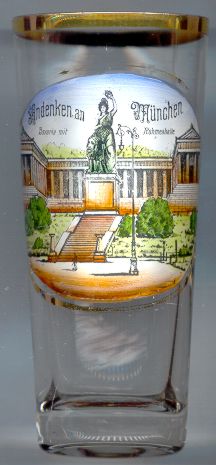
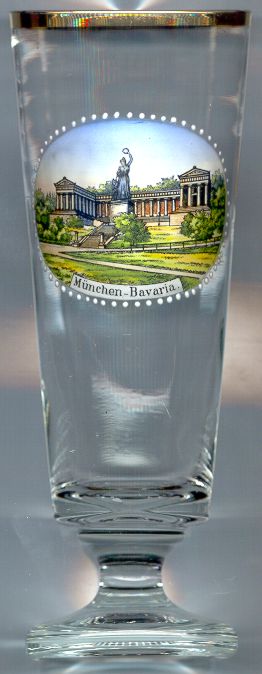
The  Ruhmeshalle (Hall of Fame) [left and right, background]
was built in 1843–1853 on a hill above the Theresienwiese as a memorial to people that had rendered outstanding
services in the fields of science and the arts in Bavaraia. It was commissioned by King Ludwig I and was designed by
Leo von Klenze.
Ruhmeshalle (Hall of Fame) [left and right, background]
was built in 1843–1853 on a hill above the Theresienwiese as a memorial to people that had rendered outstanding
services in the fields of science and the arts in Bavaraia. It was commissioned by King Ludwig I and was designed by
Leo von Klenze.
The  Bavaria statue [foreground] was designed by
Ludwig Schwanthaler and was cast by Ferdinand von Miller in 1850. The bronze statue has a height of 18.5 metres
and until today is considered a technical masterpiece.
Bavaria statue [foreground] was designed by
Ludwig Schwanthaler and was cast by Ferdinand von Miller in 1850. The bronze statue has a height of 18.5 metres
and until today is considered a technical masterpiece.
München was also the German name of the Czech village Mnich.
[http://en.wikipedia.org/wiki/Munich; http://en.wikipedia.org/wiki/Munich_Frauenkirche;
http://en.wikipedia.org/wiki/Hofbräuhaus_am_Platzl;
https://de.wikipedia.org/wiki/Löwenbräukeller, https://en.wikipedia.org/wiki/Löwenbräu;
https://en.wikipedia.org/wiki/Maximilianeum]
![[scale]](lineal.jpg)